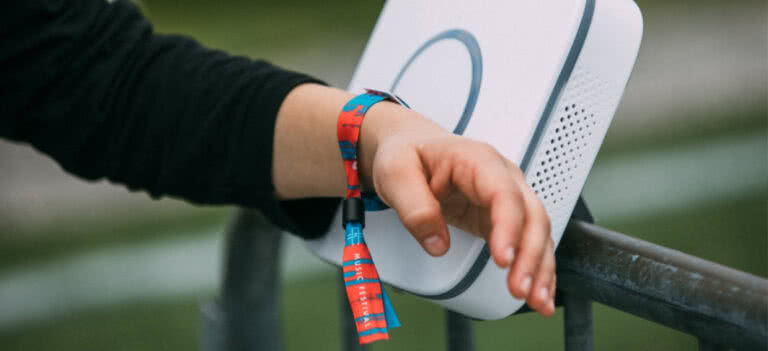RFID technology — used for hotel door-entry cards or a highway toll tags — has the power to enhance the attendee experience on all levels of your event. From speeding up entry to simplifying cashless payments and reducing fraud, even helping you prove return on investment to your sponsors, if RFID is right for your event, it can pay off big.
But not all RFID solutions are alike. Faulty wristbands or poor fulfillment, can leave attendees frustrated. Once if you know the right questions to ask a potential RFID vendor, you can be confident when upgrading your tech.
Here are five key questions to ask RFID vendors.
1. Is there a single point of failure that could bring down the entire system?
One of the biggest risks of implementing RFID is that the technology itself could fail. To address connectivity concerns, find out how your RFID provider handles connectivity loss — both to the outside world and across the event site.
What to look for: You want an RFID solution that will continue to operate regardless of power or internet, so each attendee’s wristband or card responds securely and accurately. This includes:
- An automatic switch to “offline” mode that does not increase ticket validation time
- Layers of redundancy to keep wristbands working offline
- Access if the local network, internet, or power goes down
2. How do you handle fulfillment, in advance and on-site?
Shipping wristbands to attendees is a massive undertaking and can have serious customer service implications if something go wrong. To reduce the drain on your resources, make sure your RFID fulfillment solution gives you access to track the real-time status of each order.
What to look for: Choose an RFID provider that allows attendees to track their own wristband order. That way, your staff doesn’t have to spend time answering queries from eager attendees.
You’ll also want to ask vendors these follow-up questions:
- How can attendees check the status of their wristband or report it missing?
- What’s the process for on-site fulfillment for attendees who purchased after the fulfillment date?
- How many steps will it take for fans to get their wristband on-site at the box office?
3. How do I access my RFID data?
RFID data helps you create the ultimate attendee experience. It can tell you where to place concession stands, toilets, and sponsor booths to eliminate bottlenecks within the event — or to figure out which performers or speakers were most popular.
Unfortunately, some providers may not provide direct access to the data you gather through RFID. Instead, look for a provider that offers real-time data you can access yourself.
What to look for: Ideally, you should be able to configure data in the way that is most helpful to you — filtered by ticket types or time, for example. You want live reporting about your box office and check-in process, so you can:
- Better prepare your box office and check-in staff
- See exactly how many wristbands are left in your inventory
- Know how to staff your box office when attendees come to pick up remaining wristbands
4. Who is your chip provider, and what are their quality standards?
RFID chips vary in quality. Even chips of similar specs can have drastically different read ranges and defect rates. Don’t let a low quality RFID chip shortchange your event — make sure you only buy chips from approved vendors recommended by your RFID provider.
What to look for: The last thing you want is fans showing up with wristbands that don’t work. Equally important is to use chips that are properly encrypted so that no one can copy them. Be alert for:
- Knock-off RFID chips
- Chips from vendors not approved by your provider
- Untested, unofficial chips
5. How long does it take to install and strike entry gates?
Some RFID solutions need two days to install gates and portals. If portals are being shipped in slow container trucks, it can take even longer. But when weather isn’t under your control, or the tent vendor is running late, you can’t risk a delay on setup.
What to look for: Choose an RFID solution that can be installed in hours — not days — with handheld scanners you can distribute as needed. Ensuring a speedy installation will ensure that you can:
- Prevent delays before your event
- Allow flexibility during entry to add or subtract lanes
- Streamline logistics by quicker post-event exits





